These are the casts of the legs from earlier. I am now using them to make hard Resin legs. Though I could of made silicone legs which would be easier to attach latter to the main head, I wanted to try it since firstly it was an opportunity to use a different material, and secondly I think it would make the legs look different from the rest of the cast. The first couple are a little rough around the edges but can be sanded down to look a bit cleaner, though the rough effect might help the look of a rough bug exo-Skellington. In any case it is an ideas to play with later
Posts
- Get link
- Other Apps
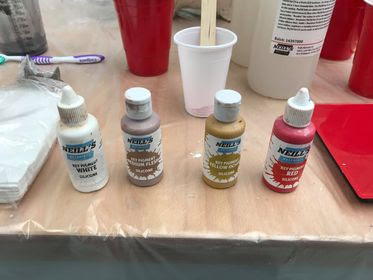
I’m know on to my second Silicone head, this one is going to be an Albino one so it's skin is a pale pink. The processes seemed to go a little quicker this time since I was more experienced with the processes second time around. I was also more careful to make sure the head was more filled in certain places like the neck and the sides of the head as last time they did not come out as thickly as I wanted. Overall, I am pleased with how it came out as it has retained a lot of the details, I wanted
- Get link
- Other Apps
I have removed the head from the mold, and it seems to of come out well. It certainly took a bit of effort getting it out, and I was worried about ripping it if I pulled it too hard, nut silicone is a fairly stretchy and sturdy material, so it was fine in the end. A Copley bit will need to be tided up dur to the air bubbles in the mold but there easy to fix. Overall, really pleased with how it came out
- Get link
- Other Apps
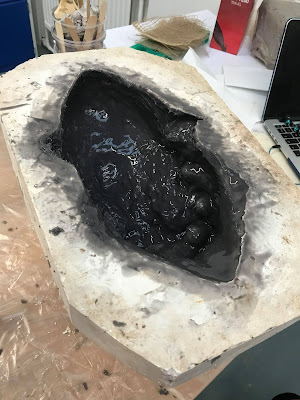
I am now on to making the first head from the mold, it is going to be made from Silicone and I am going to have it a dark color to match that of a gorilla’s skin. The way this part is done is firstly spraying the mold with a mold removal spray to help get the head out when it’s done. Then you start adding the silicone in layer’s on Silicone bit by bit. The first layer is meant to be thin and is meant to be able to cover most of mold. Once it is a bit drier but not completely you can start to focus on other parts of the mold and build the thickness up. While doing this you need to try and make sure the eyes are clear, you do not always get all of it off, but it helps with the next step. Once you have done one or two layer’s you can then add in the eyes. I made some new black resin eye’s because I wanted to see what they would look like in the end, but they can be swapped out for different ones later when the head is done. Once the silicone was dry, I removed any traces of silicone over
- Get link
- Other Apps
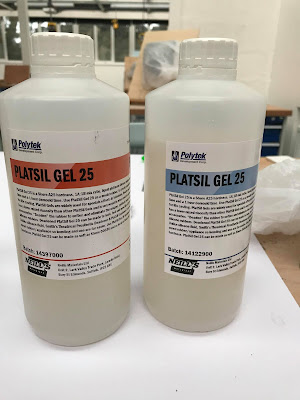
I have been doing the two-part casting of the spider leg’s in silicone and have learnt a couple of things from the processes. First thing I had to face was the fact I had left the legs out for a bit to long with out applying a sealant, which meant that they had cracked in places. I quickly sealed and re sculpted the parts that where cracked and then sprayed them with the lacquer. I then moved on to the silicone, know I have not used silicone before but as I soon learned it is not a terrible difficult material to work with. It is as simple as adding one-part A of the silicone mixture and 1 part of B of the silicone mixture, it then begins to become like rubber within roughly 20 minutes. The other thing I learnt was how the two-part casting worked. You first make a flat surface of clay with the thing you are casting half submerged in the clay. You then make holes and nibs around the cast which will help hold the two part together like a jigsaw piece. then Put up some sort of wall around
- Get link
- Other Apps
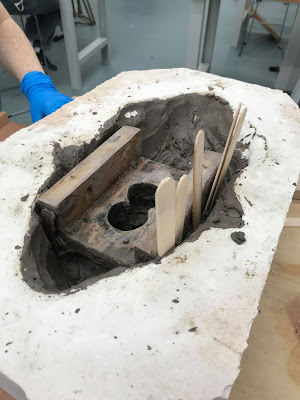
After a while of carving and scraping the clay out I am happy to say that the mold appears to of gone well. Only a couple of small air bubbles have appeared, and a slight cast, but they do not seem to be to much trouble and are thing is I might be able to fix later. The first tricky part of cleaning out the clay was the part of the board the head was stuck to and removing it, as it was very Imbedded into the clay and mold. I had a little help removing it by using wooden sticks that would be wacked around the wooden peace to help shimmy it out. After some effort I was able to get it out, and then the next tricky part was cleaning out the mold with on wooden tools and picks. Since anything else like metal tools could damage the mold. But all went well and I’m very pleased
- Get link
- Other Apps
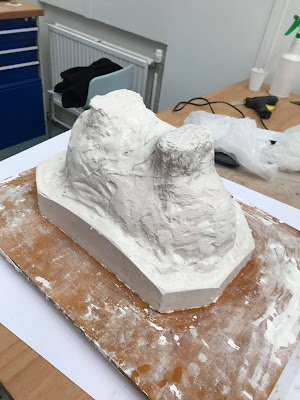
The plastering as fair as I know was a success, was very straight forward with adding 2 or so layers of plaster and then adding a material called scrim, which is a net robe like material. I believe this helps to strength and add a layered structure to the cast. I did another 3 or so layers of this and then made two flattened points that will act as leg’s out of plaster and scrim to balance it when holding the cast, the right way up. The only thing I will have to wait and see if there where any air bubbles that have survived in the cast. As air bubbles in the plaster could ruin some of the detail, but I will first need to remove the board by unscrewing in the back. Then I will begin the long and delicate processes of removing and carving out the clay without damaging the mold. Only after that will I be able to properly inspect the mold and weather it has come out ok.